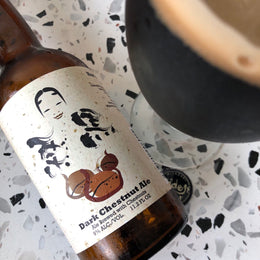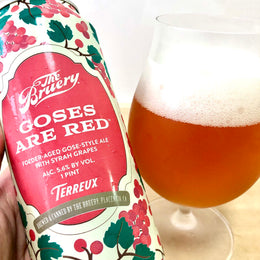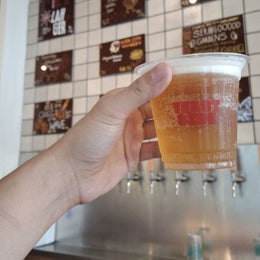
One bakery’s stale loaf is another brewer’s golden pint
Breer, an upcycling startup that turns surplus bread into beer, has collaborated with local brewery The 1925 Brewing Co. to tackle food waste uniquely.
The launch took place at Get Some’s Guillemard Road outlet. The venue had a cozy, attic-style ceiling and a warm wooden interior. A wall of beer taps lined the front of the establishment. Bright red origami fans hang from the rafters, giving the space a playful yet intimate vibe. Craft beer enthusiasts and eco-conscious community members were in attendance. Pints in hand, we celebrated this marriage of bread and brew.

The Spark Behind Breer
Breer’s story begins with co-founders Naman Tekriwal and Anushka Purohit, who were university students in Hong Kong. The team was appalled by the staggering amount of bread waste when they witnessed staff disposing of unsold bread after a late-night meal at a bakery. The lightbulb moment occurred when they were intrigued by a drink that a bartender was enjoying. It turned out to be kvass, a traditional fermented bread drink. Realizing that beer could be brewed from bread, the team had their eureka moment. Why not upcycle surplus bread into craft beer?

I was fortunate to have a conversation with Naman, who was busy with the launch. I was amazed at how Breer was born from serendipity. The team seized the opportunity and turned an abstract idea into reality. Despite no formal brewing background, the team experimented and learned independently. Naman joked about feeling like a “mad scientist” after a home-brewing mishap sent grains exploding onto his kitchen ceiling.

Anushka Purohit (second from right) and Naman Tekriwal (rightmost).
Unfortunately, the pandemic soon posed a challenge, disrupting supply chains and the brewing industry. Yet, the team pressed on, continuing with research and development. Their determination came from a clear purpose. They were brewing more than beer; they were trying to brew a solution to the waste problem.
The breakthrough came in 2023, when Hong Kong’s largest food & beverage conglomerate, Maxim’s Group, joined forces with Breer. Together, they launched Bottle of Bread (BOB), a pale ale brewed with surplus bread from Maxim’s bakery operations. The beer was rolled out across 350+ restaurants under Maxim’s portfolio, giving Breer a massive platform.

The launch happening at Get Some.
A New Chapter In Singapore
After achieving notable success in Hong Kong, Breer set its sights on new horizons. Singapore, like Hong Kong, faces food waste challenges, with surplus bread being disposed of. It also boasts a growing awareness of sustainability and support for green initiatives. This made it fertile ground for Breer’s expansion. Breer found an ideal match in The 1925 Brewing Co., an established Singaporean brewery known for its innovative beers and commitment to local culture.
The partnership with 1925 allows Breer to localize production, eliminating the carbon footprint of importing bread-based beer to Singapore. Breer can now upcycle Singapore’s surplus bread, brewing it into beer with the help of The 1925’s facilities and expertise.

Left to Right: Ivan Yeo, Uncle Yeo King Joey, Yeo Eng Kuang.
About The 1925 Brewing Co.
On to the other side of the collaboration, we have of course 1925. Founded by brothers Yeo Eng Kuang and Ivan Yeo with their uncle Yeo King Joey in 2013, it was named after the birth year of the family patriarch, Yeo Kim Ho, a dry goods grocer. He believed in providing customers with quality produce and had great pride and respect for his produce. His birth year is both a tribute and a reminder of how business should be conducted.

Today, the company distributes to numerous hotels, restaurants, and pubs. Individual bottles can also be purchased through its website. All beers are crafted with passion and attention to detail. Some signatures include the Yellow Van, inspired by their grandfather’s yellow van used to transport goods, and the BLK622, a dark ale inspired by the block number in which their grandparents resided.

Birth Of A Banana Bread Beer
This collaboration was showcased with the debut of Banana Bread Beer. In this recipe, leftover white bread was mixed with banana puree. The combination of ingredients replicates the taste of Banana Bread, a beloved teatime loaf. It is a fun twist on traditional craft beer flavors with a meaningful story. Both parties worked closely, taking 5 months from ideation to creation.
Brewing beer from bread is far more complex than using standard barley malt. Bread contains oil, sugar, and other ingredients that can affect flavor, body, and brewing consistency. Numerous test batches are brewed to pinpoint the right balance of flavours. The nature of bread also creates challenges with slurry mash, adding to the complexity of brewing.

Two varieties of hops were employed. East Kent Goldings provided roasted bitterness, while Fuggles provided a depth of flavour. This is considered a brown ale, with darker colours but lighter flavours compared to a stout.
I had the opportunity to talk to Eng Kuang from 1925, who shared that the bread was toasted to achieve nuttiness and increased depth. This was meant to complement the fruity dimension of the banana.
Beer Review: Banana Bread Breer, Breer x 1925 Brewing, 5% ABV

Tasting Notes
Nose: Freshly baked banana bread with flambeed bananas, topped with opulent vanilla ice cream. Caramel notes make this even more indulgent. Reminiscent of peeling an overripe, brown-speckled banana. Banana milk, chocolate and malt complemented by an aromatic profile. Brown sugar is lifted by subtle floral hops. Beneath it all are hints of coffee, cocoa, and red raisins.
Taste: Velvety, creamy banana milk balanced by a crisp, refreshing hop bitterness. Sweet orange pound cake, banana cake, and digestive biscuits provide the malt backbone. Floral notes and lemon citrus brighten the palate. It cuts through the heavier flavours, enticing me to take another sip.
Finish: Medium Long. Creamy, some dark chocolate, and Maltesers. This gives way to blueberries with that slight acidity. The lemon citrus synergizes with the malt, reminiscent of our local lemon barley drink.
My Thoughts
This is downright irresistible. Before I realized, my glass was empty. And I just had to have another pint. Traditionally, darker foods carry bolder flavors, and the same applies to rich stouts or porters, which pair beautifully with hearty stews, meats, or indulgent chocolate. I love how it begins with an assertive, robust profile, which mellows into tropical fruits and floral notes. Towards the end, acidity livens it up, and the hop bitterness cleanses the palate. However, the malty flavours lingered. This constant ebb and flow of flavours compels me to take sip after sip. Honestly, it will never grow dull, even after a few pints.
I arrived at the event around four in the afternoon, hoping to avoid the evening rush. Still satisfied with lunch, I skipped the food pairing. I found comfort in a refreshing pint while warm sunlight streamed through the windows. Those peckish dove into mentaiko fries, the crisp, fruity beer cutting through the fries’ creamy richness. As dusk approached, the beer’s versatility proved itself once again. It paired effortlessly with substantial dinner dishes.

Penned by Pivoine







